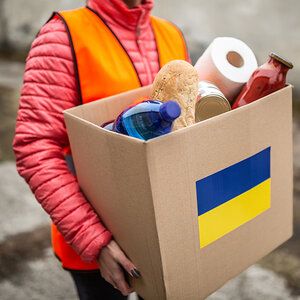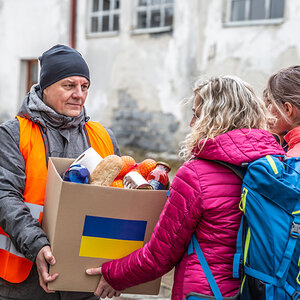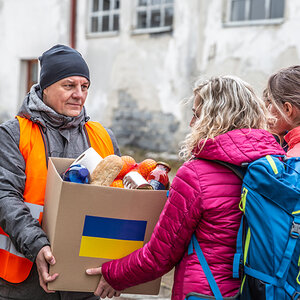Ukraine one year on: Aid and relief stay front and center

As the Russian invasion of Ukraine reaches the one-year mark, global philanthropy remains attuned to the ongoing need for humanitarian aid, and major funders and nonprofits continue their efforts to deliver needed relief with an eye to the future even as the conflict continues with no end in sight.
The United Nations Office of the High Commissioner for Human Rights (OHCHR) has verified 8,006 civilian deaths during Russia’s invasion of Ukraine—among them 487 children as of February 21. An additional 13,287 people were reported to have been injured. OHCHR noted that the actual figures will be considerably higher but will only be known after hostilities have ended in what will likely prove to be the costliest, most violent and disruptive conflict in Europe since the end of World War II. In November, United States Joint Chiefs of Staff chairman General Mark Milley estimated the number of soldiers killed on each side of the conflict may be as high as 100,000, with as many 40,000 civilian casualties, the BBC reported.
The United Nations High Commissioner for Refugees (UNHCR) reports that 5.9 million people have been internally displaced while 7.8 million—90 percent of whom are women and children—have fled to neighboring countries and across Europe. Prior to the February 2022 invasion, nearly three million people were already in need of humanitarian aid across Ukraine, including more than 850,000 internally displaced people, following the 2014 Russian annexation of Crimea and the ongoing conflict in eastern Ukraine.
The philanthropic response
According to Candid data, as of the end of January, foundations and NGOs around the world have awarded 1,591 grants totaling more than $1.58 billion, and announced an additional 194 pledges totaling $1.21 billion. This represents a 44.7 percent growth in grants and pledges since our initial reporting in July 2022, and a 3.7 percent increase since our year-end review in December.
The experience of Jewish Federations of North America (JFNA) and Americares—two public charities that were engaged in direct relief and humanitarian aid to Ukraine even before the Russian invasion—is emblematic of the challenge of fundraising and providing ongoing support as the conflict has transitioned from providing emergency relief to sustaining programs in the near and long term.
We are talking to our partners about limited efforts to rebuild...but our current focus remains on emergency rescue and humanitarian aid to ensure the safety and security of those affected by the conflict.
— Eric Fingerhut
JFNA
JFNA has raised $85 million for humanitarian aid to Ukraine—providing humanitarian aid to 500,000 people, medical care to 130,000, and training to 4,000 medical and mental health professionals, while sustaining more than 80,000 Jewish refugees and those of other ethnicities inside Ukraine and neighboring countries, and helping 65,000 people immigrate to Israel. In collaboration with the Boston-based Shapiro Foundation, JFNA also has helped resettle Ukrainians in 18 Jewish communities across the U.S. and Canada. The fundraising, while significant, represents one piece of the projected $99 million in additional funding JFNA estimated its partners in Ukraine and across Europe would need in 2022. “I don’t think any of us imagined that the war would be going on this long or would be this bitter,” JFNA president and CEO Eric Fingerhut told the Washington Times in December.
Americares, a Connecticut-based relief and development organization that supports local health systems during natural disasters and armed conflict, has provided more than $70 million in aid over the past year to meet the health needs of displaced families and survivors of the war in Ukraine, including $63 million in medicine and relief supplies to 32 partner organizations. While the number of internally displaced people continues to rise and healthcare facilities and energy infrastructure come under increasing threat, the organization has also awarded $1 million to provide heat and power to health facilities across Ukraine and distributed $3.3 million in medicine and supplies to 20 U.S-based volunteer medical teams traveling to Poland, Romania, and Ukraine.
“We are continuing to focus on mental health and psychosocial support for families impacted by the war and providing funding and technical assistance for safeguarding and protection needs for vulnerable populations,” said Americares senior vice president of programs and chief medical officer Julie Varughese.
Since February of last year, Americares has provided crisis intervention services to 17,000 internally displaced people, military personnel, veterans, and refugees. “As we approach the one-year mark of the war, we recognize that more work has to be done, and we are committed to meeting the physical and mental health needs of those affected,” said Americares director of complex emergencies Adam Keehn in a statement.
Ukraine in the global context
The war in Ukraine was not the only humanitarian crisis of the past year, though it has served to bring into focus the limits of international philanthropy and multilateral efforts to address global systemic challenges. The Organization for Economic Cooperation and Development (OECD) has estimated that the conflict has hobbled the world economy, reducing global output by as much as $2.8 trillion. What’s more, high inflation, made worse by shortages of grain from Ukraine and spikes in fuel costs triggered by global sanctions on Russian oil and gas, have exacerbated humanitarian crises, particularly in Africa, where drought and food shortages have brought millions to the brink of famine, and Haiti, where a cholera epidemic continues unchecked following political turmoil and an earthquake in 2022.
Compounding the challenge of these interconnecting crises, the urgent need to provide aid following the recent earthquakes in Turkey and Syria—in yet another region at war—underscores how the complicated landscape of relief and humanitarian aid continues to become even more fraught as the war in Ukraine continues.
We must do all we can to reach the hardest-to-reach communities. The suffering of the Ukrainian people is far from over—they continue to need international support.
— Martin Griffiths
United Nations
Earlier this month, OCHA and UNHCR jointly appealed for $5.6 billion in support of their Humanitarian Response Plan for Ukraine to fund 650 partners—most of them Ukrainian organizations—calling for $3.9 billion to reach 11.1 million people with food, health care, and cash payments, and the Refugee Response Plan calling for $1.7 billion to fund 250 partner organizations across Eastern Europe supporting an estimated 4.2 million refugees who will remain outside Ukraine for the foreseeable future. According to UNHCR, 40 percent of Ukraine’s population needs direct humanitarian assistance.
“Almost a year on, the war continues to cause death, destruction, and displacement daily, and on a staggering scale,” said UN under-secretary-general for humanitarian affairs and emergency relief coordinator Martin Griffiths in a statement. “We must do all we can to reach the hardest-to-reach communities. The suffering of the Ukrainian people is far from over—they continue to need international support.”
In February, the British Disasters Emergency Committee (DEC) announced that its 15 member charities had raised more than £400 million (over $432 million), making it the largest nongovernmental donor to the Ukraine funding appeal made by the United Nations Office for the Coordination of Humanitarian Affairs (UN OCHA). In addition, the UK government matched £25 million ($30.25 million) in public donations to the DEC, its largest-ever commitment through UK Aid Match, the Evening Standard reports. The DEC funds have provided 1.9 million people with access to clean water, 392,000 with food, 338,000 with cash payments, 114,000 with legal aid, 71,000 with access to health care, and 10,000 with temporary housing.
“The crisis has been so huge, so widespread, and so devastating,” DEC chief executive Saleh Saeed told the Evening Standard. “The level of funds raised means that we can keep providing that support, as we know that this crisis is far from over with needs developing and changing all the time as the situation unfolds.”
Far from over
With the prospect that the war has entered an indefinite state of long-term conflict that necessitates ongoing relief and circumscribes meaningful planning for post-war development and reconstruction, the philanthropic community has begun to engage in broader conversations to bring focus to the wide-ranging challenges facing Ukraine, with the hope that such exchanges will “lead to more foundations designing and doing something for the long term,” such as addressing the environmental degradation caused by the war by developing a renewable energy economy, suggested Nick Deychakiwsky, senior program officer for the Civil Society program at the Charles Stewart Mott Foundation—which has provided more than $2.7 million to partners across Europe in support of refugee legal services. Since October, the German Marshall Fund of the United States, in collaboration with the Council on Foundations, Community Foundations of Canada, Philanthropic Foundations Canada, and Mott have engaged in monthly briefings to explore what areas philanthropy could address in the near and longer term, including the continuing need for humanitarian support, “especially to get through the winter while Russia was attacking Ukraine’s energy infrastructure.”
“We are talking to our partners about limited efforts to rebuild,” said JFNA’s Fingerhut, “but our current focus remains on emergency rescue and humanitarian aid to ensure the safety and security of those affected by the conflict.” As the war continues into its second year, “we know that the needs continue to grow.”
(Photo credit: Getty Images/Marian Vejcik)







